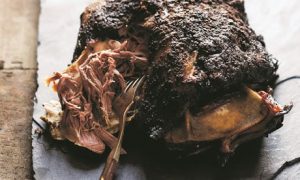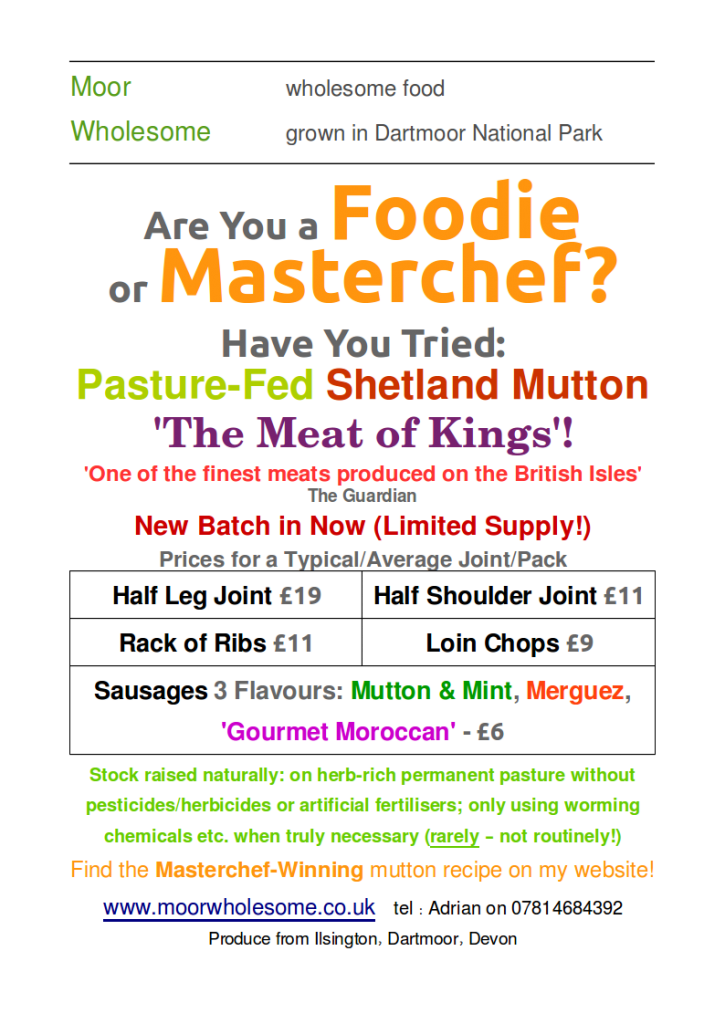Scroll down for Shetland Mutton prices and availability…
Shetland Sheep for Sale – see here. Advice/Training available if you are new to smallholding.

See the Masterchef-Winning mutton shoulder recipe here!
Shetland Mutton (including 3 varieties of Sausages) Available Now!
Prices
Pricing information for individual cuts/packs of Moor Wholesome Shetland Mutton can be seen in the table below:
| Cut/Pack | £/Kg | Typical Cut/Pack Price |
|---|---|---|
| Loin Chops (pack of 4) | 17.99 | £9.00 |
| Rack | 16.99 | £11.00 |
| Half Shoulder (on Bone) | 11.99 | £11.00 |
| Whole Shoulder (on Bone) | 11.99 | £29.50 |
| Half Leg (on Bone) | 15.99 | £19.00 |
| Whole Leg (on Bone) | 15.99 | £32.00 |
| Merguez Sausages | 12.99 | £6.00 |
Shetland Sheep
I keep Shetland sheep for a number of reasons, including, but not limited to:
- the supreme quality and taste of the meat
- their ability to thrive on ‘unimproved pasture‘
- their ruggedness and strong natural mothering instincts
- unlike other breeds, no need to ‘dock’ tails as a precaution against ‘fly-strike’
For details of this versatile breed see the Shetland Sheep Society.
As a slower-maturing breed, I offer ‘hogget’ (animals in their second year) instead of lamb, as well as mutton (older ewes that are still in good condition – definitely not ‘end-of-life’ cull-ewes!) : mutton is recognised as ‘one of the finest meats produced on the British Isles‘! – see below for why this is a supreme meat! Smaller roasting joints (e.g. half-leg or half-shoulder) are suited to small family meals rather than catering for a large dinner party; a slow-roasted and flavoursome whole leg or shoulder of hogget or mutton, though, can feed more people easily, with some left over for later!
Shetland Hogget – ‘cook it as lamb – it has a little more flavour’
Hogget meat is from animals killed in their second year, as opposed to lamb, which is killed in its first year (although it is not unknown for meat marketed as ‘lamb’ to have been killed in its second year). The meat is still relatively tender and ‘sweet’, although with a little more flavour than lamb. With a primitive breed such as Shetlands, the extra year means that the carcass size provides more meat than a Shetland lamb would – this is particularly true as my sheep are pasture-fed (with additional haylage/hay in winter) rather than fattened with ‘concentrates’ in their first year in order to be sold as lamb. Being pasture-fed, the meat develops a healthier balance of Omega-3 and Omega-6 fats than occurs with concentrate-fed animals. These are not as big as commercial breeds that are fattened for the mainstream market, and some joints are suitable for small family meals.
Why eat mutton?
First of all you must recognise that the associations with the word ‘mutton’ that you are likely to carry around with you are misleading and must be jettisoned – phrases such as ‘mutton dressed as lamb’ and childhood memories of tough school meals amount to slander on what was historically ‘the meat of kings’. The Victorians cherished mutton, and were skilled in the slow-cooking techniques that make the most of the meat’s qualities (while slow-cooking is recommended to bring out the best qualities of large roasting joints, chops and racks of ribs can be cooked as lamb). When and where did it go wrong? Changes to the economics of rearing sheep due to the collapse in wool prices (favouring the eating of lamb) and the development of a fast-food culture during the last century led to an erosion of the skills of preparing and cooking mutton – certainly in mainstream culture. Properly cooked mutton became a well-kept secret. Now that is changing!
Britain’s discovery of a gastronomic confidence, and in particular the popularity of TV programmes about cooking and rise of the ‘master chef’, have led to a rediscovery of well produced and appropriately cooked mutton – it is part of a revival of interest in our food heritage, as typified by the Slow Food movement. As a Guardian newspaper food critic has pointed out, mutton is ‘one of the finest meats produced on the British Isles‘! It is ideally suited to slower cooking, in traditional dishes such as Lancashire Hotpot or slow-roast leg of mutton, as well as more exotic alternatives such as curries and tagines. Chops and cutlets do not necessarily need to be slow-cooked, but there are some lovely recipes out there such as braised mutton chops with cider and root vegetables.
Mutton Renaissance has more details about mutton, including some interesting recipes.
The Electric Scotland website also has a wealth of material on cooking mutton.
Even with rare breed pork and Dexter Beef in the freezer, when we are looking for something a bit special we go for a slow-roast leg or shoulder of mutton, braised in red wine with garlic and rosemary – once you have tried it you will realise why!
Why eat Shetland mutton?
Bear in mind all of the above about the supreme eating experience that is properly cooked mutton, and throw into the mix the special qualities of Shetland meat: aside from its outstanding flavour, it is less fatty than modern commercial breeds, with a finer texture. Not all mutton cuts need to be slow cooked – if the carcass has been hung properly (e.g., minimum of 2 weeks), then chops and racks of ribs are perfectly fine to be eaten cooked in the traditional manner.
Availability
I will have some limited availability in August 2020!
More recipes
The BBC has a range of recipes for mince, including Shepherds Pie, Moussaka and Kebabs.
Here is a short youtube video of a slow roast whole leg of Scotch Blackface mutton (10 hours at 100C, followed by browning off at 240C).
Search the internet for more mutton recipes – there are a lot of great ideas out there!